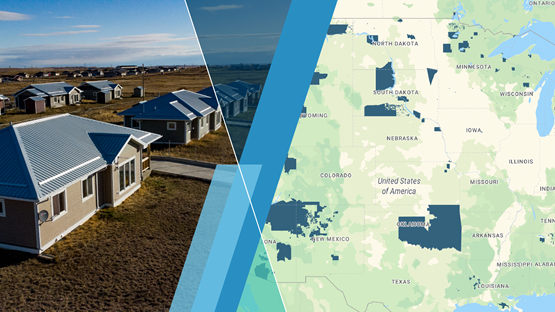For my people, the Salish, when the Mission Valley on the Flathead Reservation is first blanketed with snow, a new cultural season is underway. Traditionally, winter ushers in a time when we tell our stories and reflect on our histories, weaving in life lessons to remind us of where we’ve been and who we want to be as a people, as a Native nation.
As snow surrounds me in Montana, I find myself reflecting on data conversations that have unfolded in Indian Country since the first snow fell last year. Much has been shared in and outside of our tribal communities regarding the data gaps in Indian Country and how they perpetuate the invisibility of Native people to funders, bankers, policymakers, and the general public. In no time during our modern history have data been more woven into the daily dialogue of tribal leaders and policymakers.
The Center for Indian Country Development (CICD) has engaged in many of these conversations about how to collect accurate, comprehensive data with Indian Country in ways that honor tribal data sovereignty. As I consider our collective work to address these harmful gaps, I take comfort in history. Since time immemorial, Native people have leveraged Indigenous ways of knowing and traditional knowledge to promote the well-being of our communities. This historical experience reassures me as we look to the future.
Data and our knowledge systems
Over the holidays, my brothers, dad, and I shared stories of a recent q̓ʷeyq̓ʷay (buffalo) hunt we did in our tribe’s aboriginal hunting grounds in southwestern Montana. We filled our grandparents’, parents’, aunties’, and our own freezers with enough meat to feed our families for a couple of years. Even though it was a one-day hunt, it took months to plan. Reflecting on the sheer volume of information we needed to carry out the hunt got me thinking about the traditional q̓ʷeyq̓ʷay hunts the Salish did in our part of the world.
Before modern transportation and technology, Salish leaders had to orchestrate what today we’d consider a logistics miracle: traveling hundreds of miles of mountainous terrain and navigating major river systems to the q̓ʷeyq̓ʷay and returning with enough meat to feed our community for another season. The success of these hunts depended on a deep knowledge and understanding of the natural world that, in modern terms, we could consider a form of data. To drive their decision-making, our leaders relied on information regarding the skills and training needs of the hunting party, horse and supply inventories, demand for and supply of meat in the community, q̓ʷeyq̓ʷay migration patterns, location of supplemental foods, climate indicators, transportation logistics, and any hunting competition, friendly or otherwise.
Given the importance of our traditional hunts, leaders made decisions and plans with great care, incorporating an incredible amount of traditional knowledge and information. While these data didn’t live on rows of spreadsheets or in complex datasets as they do today, Salish leaders were experts in interpreting information found in the physical and spiritual world and relying on this knowledge to make the best decisions for their communities—not just for q̓ʷeyq̓ʷay hunts, but for sustaining the well-being of our families. In this way, they incorporated data into many daily decisions, such as producing our medicines, harvesting bitterroot, moving to seasonal camps, and preparing for trade gatherings with other tribes. Tribal needs drove these data.
Using data and our traditional knowledge systems was central to our survival. It still is today.
Understanding Indian Country today
Information-gathering systems for the Salish and much of Indian Country have had to evolve. Many would argue that our data evolution has been relatively slow to develop in the modern context. There are good reasons for this. Historically, there have been far too many instances of tribal data being misused or misrepresented to undermine the sovereignty and economic prosperity of tribal communities. In addition to the history of data misuse, tribal governments have also been in the position of directing precious resources toward defending their sovereignty and managing essential government services—limiting their capacity to invest in data systems.
Today there is great diversity in data capacities within tribal governments and communities. Some tribes have robust systems for collecting and working with data. Complex data are a part of their operating business and governance model. Others store critical data in the minds and stories of cultural or tribal leaders.
This patchwork of data experience across the hundreds of tribes, Alaska Native villages, and Native Hawaiian Homelands makes for a complex and complicated data environment for understanding the collective economic conditions of our Native communities. There isn’t a complete picture of Indian Country that’s anchored in data—yet.
Data take central stage
Though considerable gaps remain, a new era of data collection, use, and governance has gathered steam in conversations among tribal leaders and their partners. At the heart of these conversations is tribal data sovereignty. Over the past several decades tribes have strengthened and exercised their inherent sovereignty as Native nations. These efforts have increasingly extended to the governance of our own data as Native people—collecting, securing, analyzing, and sharing data on our own terms. Policymakers and practitioners now recognize tribally certified data as vital in economic self-determination—necessary for understanding tribal needs and opportunities and informing decision-making. Research partnerships with tribes are expanding, tethered to agreements that amplify and not diminish tribes’ right to call the shots regarding their data.
Data are also becoming increasingly essential to tribal governments in delivering public goods in responsive ways. As a result, individual tribes have increased data collection and utilization.
For example, the Bay Mills Indian Community in Michigan just executed a first-ever tribal census to gather community data that could enhance service delivery. The Confederated Salish and Kootenai Tribes in Montana recently partnered with the University of Montana to evaluate tribal workforce needs—an effort that resulted in new educational programming at the tribes’ college, Salish Kootenai College. For several years the Ysleta del Sur Pueblo tribe in Texas has conducted a tribal census which helps the tribe direct workforce opportunities for its members. These are just a few of many examples across Indian Country.
In addition to efforts at the tribal level, national survey institutions are beginning to address low American Indian and Alaska Native sample sizes in their survey instruments. The U.S. Census Bureau has increased its investment in tribal engagement staff and continues to lean on tribal consultations, tribal staff, and tribal input in preparation for the next Decennial Census. The Census Bureau also adjusted methods to increase Native representation in the annual American Community Survey, including expanded use of in-person visits. In 2022, the Federal Reserve Bank of Cleveland, in partnership with CICD, rolled out a new Native-specific module in the nationwide Small Business Credit Survey to deepen understanding of the credit conditions of Indian Country businesses. While these survey advancements don’t solve all of the data concerns in Indian Country—such as concerns about how new privacy protection methods could make Indian Country data less accurate—they reflect greater inclusion of our people.
Recently, the federal government partnered with all 574 federally recognized tribes to support their collection of tribal enrollment and employment data. For the first time in history, federal agencies leveraged self-certified tribal data to distribute billions of dollars in emergency relief funds. Following this historic use of tribal data, federal agencies convened a data working group to identify other data partnership opportunities with tribes across the country.
Financial institutions, including Native Community Development Financial Institutions (CDFIs), are also investing time and money into partnering with Indian Country to fill these gaps. Organizations like the Oweesta Corporation and the Native CDFI Network have partnered with Native CDFIs to study loan data and evaluate the impact of their credit outlays in tribal communities. At the end of last year, Wells Fargo and the Aspen Institute hosted tribal leaders and policymakers to identify the types of economic data that would influence investment decisions in Indian Country.
Research institutions like CICD, the Harvard Project on American Indian Economic Development, and the Native Nations Institute are making hard-to-use public data more accessible through new data tools, economic research, and briefs that expand policymakers’ understanding of tribal governance and economics.
Guided by our research principles and an expanded staff, CICD has multiplied our suite of data tools available to the public and invested time and expertise into building and analyzing new datasets to deepen our collective understanding of what is possible in Indian Country economic development. We’ve shared research throughout Indian Country and hosted discussions on the intersection of data, research, and good economic policy. Projects are rooted in input from tribal stakeholders, policymakers, and our CICD Leadership Council.
Braiding tradition and modern systems
This data revolution is nothing short of remarkable and necessary. Our people are braiding our traditional knowledge practices with modern data systems at frequencies and depths never seen before and in ways that allow us to articulate an Indigenous future.
Looking ahead to the next phase of these data conversations, more and more I hear positive examples of how economic data that are harmonized across tribes could improve policies serving Native people at local and national levels. Such inter-tribal data would allow tribes to correct the myths and misconceptions that we have endured for centuries. These might include data on Native businesses, tribal public finance, investment opportunities in Indian Country, credit availability, the state of tribal infrastructure, and housing and labor market outcomes, among other possibilities. High-quality inter-tribal data would complement the lived experience of Indian Country and allow us to pen our own accurate economic narrative.
And perhaps that’s what it all comes down to: penning complete and accurate narratives that break the cycle of invisibility. To do this, we can lean into our tradition of being knowledge keepers and our modern understanding of what it means to honor tribal data sovereignty. Trusted partners are at the doorstep of Indian Country eager to learn and collaborate, and CICD is honored to be one such partner—one foot in the past, and another in the future.
Casey Lozar is a Minneapolis Fed vice president and director of our Center for Indian Country Development (CICD), a research and policy institute that works to advance the economic self-determination and prosperity of Native nations and Indigenous communities. Casey is an enrolled member of the Confederated Salish and Kootenai Tribes and he’s based at our Helena, Mont., Branch.





